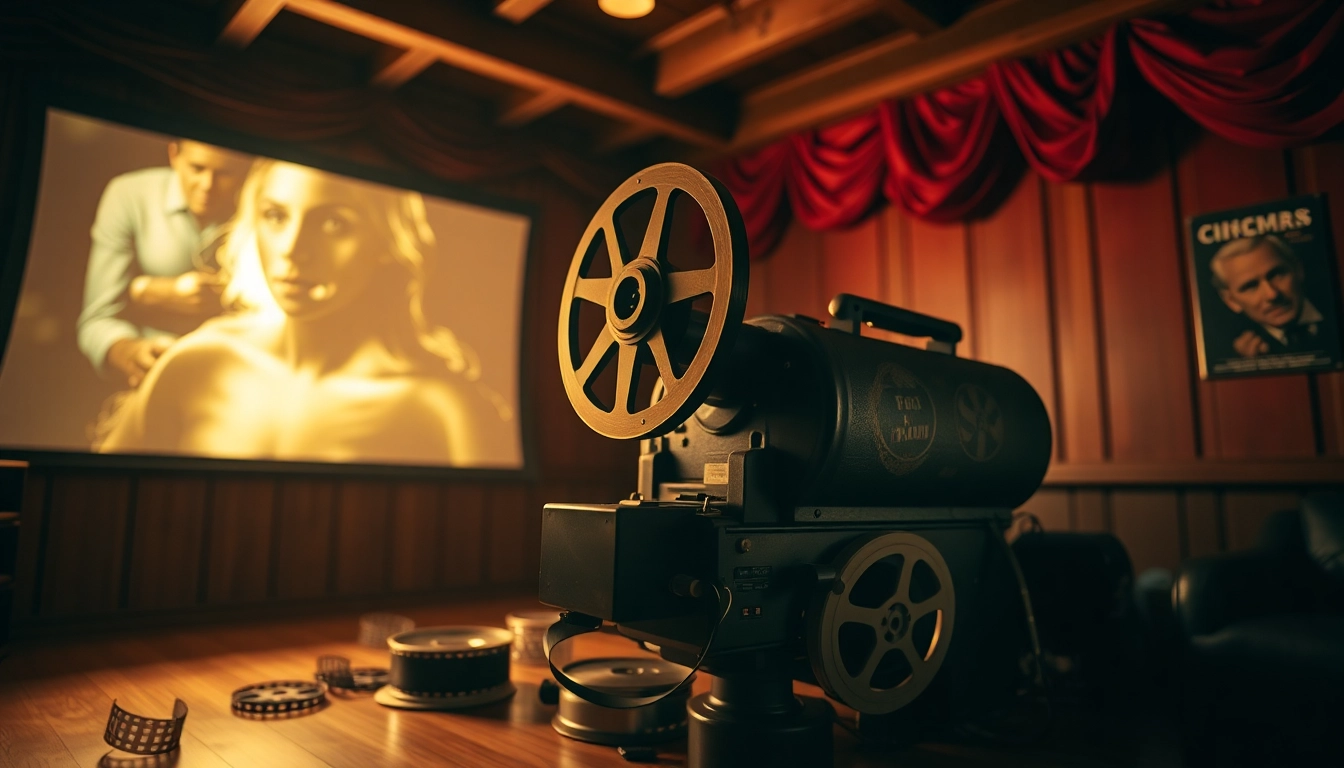Understanding Public Domain Movies
What Are Public Domain Movies?
Public domain movies are films whose copyrights have expired, making them free for anyone to use, share, and adapt without permission or payment. This designation is crucial in the film industry since copyright laws prevent unauthorized distribution of many films. Essentially, public domain movies are treasures waiting to be discovered and appreciated by audiences without the typical restrictions associated with copyrighted works. This enables filmmakers, educators, and fans alike to engage with cinematic history in unprecedented ways. For those interested in exploring these films, Public Domain Movies provides a rich resource of classic films accessible online.
The History and Evolution of Public Domain
Public domain as a concept has evolved significantly over time, shaped largely by changes in copyright laws and the media landscape. The origins can be traced back to the inception of copyright laws in the early 18th century when the primary aim was to protect the works of authors and inventors. Over the years, as copyright durations expanded and new works proliferated, many older films eventually fell into the public domain.
In the United States, the Copyright Act of 1976 initially provided protection for the life of the author plus 50 years, which was later extended to life plus 70 years with the Copyright Term Extension Act of 1998. However, works created before 1928 are now in the public domain. This period marks a booming era for silent films and early talkies that, due to their age, are now open for public enjoyment.
How Copyright Affects Film Availability
Copyright significantly impacts the availability of films. While many movies produced in the past continue to be held under copyright, others have been made accessible through their entry into the public domain. The varying durations of copyright can make access to classic cinema complex, as legal ownership can shift and rights can be inherited or sold, obscuring the availability of films.
The emergence of digital platforms amplifies these complexities. Some films may have partial copyright protection, particularly if they contain music or footage that remains protected. Determining if a film is public domain means checking its publication date, copyright status, and any associated licenses, which can require careful investigation. Educating oneself on copyright laws helps in understanding the landscape and navigating the rich catalog of public domain films effectively.
Finding Public Domain Movies
Top Resources for Public Domain Films Online
Finding public domain movies has become increasingly accessible thanks to various online platforms. A few of the top resources include:
- Internet Archive: This nonprofit library offers a vast collection of public domain films, including historical documentaries and classic animations.
- Public Domain Torrents: This site specializes in a collection of movies that are entirely public domain, with downloadable formats ideal for users.
- The National Film Registry: A part of the Library of Congress, this database keeps a list of significant American films that have been selected for preservation, some of which have entered the public domain.
- IMDb’s Public Domain Movies: This platform provides a curated list of films which are now part of the public domain, often ranking them based on viewer ratings.
- Loc.gov: The Library of Congress’s site offers various public domain films that can be streamed or downloaded.
How to Verify Public Domain Status
Verifying whether a movie is genuinely in the public domain is crucial to avoid legal complications. Here are some tips to ascertain a film’s status:
- Check the Copyright Notice: Films released prior to 1978 may have a copyright notice. If it’s absent, there’s a possibility it is in the public domain.
- Consult Reputable Databases: Resources such as the Copyright Office’s website and Wikipedia’s lists of public domain films are good places to validate status.
- Examine Release Dates: As a general rule, films made before 1928 are free to use in the United States.
- Seek Expert Assistance: If in doubt, consider reaching out to copyright law experts who can clarify a work’s status.
Best Practices for Downloading Movies
Downloading public domain films can be an enjoyable experience if done safely and legally. Here are some best practices to consider:
- Use Trusted Sites: Always download from reputable websites to avoid copyright infringement and malicious software.
- Avoid Low-Quality Versions: Some downloads may come with poor quality video or audio. Look for sites that offer high-resolution versions.
- Check File Formats: Ensure the downloaded file format is compatible with your devices (e.g., MP4, AVI).
- Respect Community Guidelines: Some platforms have specific usage guidelines; adhere to these to maintain community standards.
Popular Genres of Public Domain Movies
Classic Horror and Sci-Fi Films
The genres of horror and science fiction are rich in public domain offerings, showcasing some of the most iconic cinematic experiences. Classics such as Night of the Living Dead (1968) served as a cornerstone for horror cinema while being a case study in independent filmmaking. Movies like Metropolis (1927) exemplify early science fiction, blending art and technology in visually stunning narratives.
Timeless Romance and Drama Movies
Romantic films such as His Girl Friday (1940) and It Happened One Night (1934) captivate audiences through memorable performances and witty dialogues. These films not only reflect cultural standards of their times but also remain relevant with engaging storylines that transcend eras. Classic dramas like Rebecca (1940) stay beloved for their powerful narratives and rich character development.
An Overview of Animated Public Domain Films
Animation is another genre dotted with gems in the public domain. Early animations such as Steamboat Willie (1928) marked significant milestones, while films like Gulliver’s Travels (1939) transformed how narratives could be told through animated mediums. Public domain cartoons provide not only entertainment but also insight into the evolution of animation as an art form.
How to Enjoy Public Domain Movies
Creating Your Own Movie Nights
One of the joys of public domain films is the ability to host themed movie nights. Selecting a genre or a director and curating a list of public domain titles can create a captivating experience. For example, a classic horror night featuring films like Nosferatu (1922) alongside Night of the Living Dead raises discussions on the evolution of horror through the years.
Tools such as online viewing platforms, digital projectors, and home theater systems can enhance these movie nights. Incorporating snacks and themed decorations can also heighten participation and enjoyment, making these gatherings memorable events.
Sharing Public Domain Films Legally
Sharing public domain films is not only legal but encouraged! Hosting viewing parties or online watch-alongs are popular ways to introduce friends to these hidden gems. Websites and platforms that facilitate watching together can enhance the experience, enabling viewers to engage through shared commentary and reactions. Additionally, sharing links to public domain catalogs can be satisfying, encouraging a broader appreciation of classic cinema.
Using Public Domain Films in Education
Public domain films serve as excellent educational tools across a variety of subjects, including film studies, history, and the arts. Teachers can incorporate films into lesson plans to illustrate historical contexts or explore narrative techniques and cinematic styles.
For instance, using a film like The Great Train Robbery (1903) can allow students to analyze early filmmaking techniques while discussing the socio-political environment of the early 1900s. Educators have the freedom to adapt these films into various formats—showing clips, holding discussions, or even creating projects based around them—all while respecting copyright regulations.
Future of Public Domain Movies
Upcoming Films Entering the Public Domain
As time passes, new works continually enter the public domain. In 2024, it is expected that several iconic works, including certain Disney films and seminal horror classics, will become available for public use. Such transitions augur well for film enthusiasts, as they can experience these works freely and legally.
Monitoring lists and updates related to upcoming public domain films can provide insight into what classic titles to look forward to. Engaging with film communities online can also provide firsthand updates and discussions surrounding these newly accessible titles.
Trends in Film and Copyright Law Changes
The landscape of film and copyright law is fluid, and recent trends indicate a growing discussion surrounding the need for reform. As digital media expands, the public’s access to cinema faces challenges related to ownership and distribution. Activists and creators advocate for more works to be ushered into the public domain, arguing that timely access to artistic works should outweigh extended copyright protections that hinder cultural progress.
Changes in laws, such as those seen with the Sonny Bono Copyright Term Extension Act, have sparked debates about the relevancy and impact of extending copyright terms and the need for a more equitable system that recognizes artistic merit in the public discourse.
The Role of Streaming Services in Public Domain Access
As streaming services become increasingly popular, their role in providing access to public domain films is vital. Platforms like YouTube, Tubi, and Internet Archive initiate the preservation and promotion of these movies by curating extensive collections. While many of these films may not be available on mainstream platforms, services dedicated to classic cinema are emerging, allowing users to enjoy public domain films anywhere, anytime.
Partnerships between educational institutions and streaming services can also potentially create curated collections that facilitate easy access for learners exploring film history or particular genres. As public awareness of copyright issues grows, demand for easy-to-access public domain content will likely increase, prompting more platforms to include them in their offerings.



